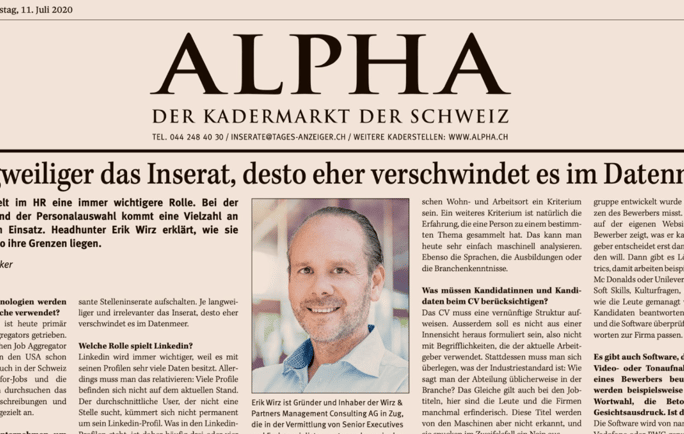
Tages-Anzeiger - ALPHA OF THE SWISS EXECUTIVE MARKET Interview with Wirz-Partners
Tages-Anzeiger - ALPHA OF THE SWISS EXECUTIVE MARKET Interview with Wirz-Partners
"The more boring the job advertisement, the more likely it is to disappear in a sea of data".
Information technology is playing an increasingly important role in HR. Various software tools are used to search for and select candidates. Headhunter Erik Wirz explains how they work and where their limitations lie.
Interview: Stefan Krucker
Erik Wirz, what technologies are being used to recruit today?
Today, job postings are mainly driven by job aggregators. An example of such a job aggregator is Google for Jobs, which has been active in the United States for some time and was launched in Switzerland in 2019. Google for Jobs and other job aggregators scour the internet for job ads and display them to job seekers.
What does a company have to do to be considered by these aggregators?
Practically nothing: if the company posts the job on its website, it will automatically be found and categorised by the job aggregators. The challenge is competition: companies are not usually the only ones looking for professionals. The prominence of an ad depends, among other things, on the behaviour of job seekers. If an ad is viewed for a longer period of time or clicked on frequently, it will be displayed more prominently than other ads in the future. Therefore, it is crucial to post meaningful and interesting job adverts. The more boring and irrelevant the ad, the more likely it is to be lost in a sea of data.
What is the role of Linkedin?
Linkedin is becoming increasingly important because it has a huge amount of data through its profiles. However, this needs to be put into perspective: many profiles are not up to date. The average user who is not actively looking for a job does not constantly update their Linkedin profile. As a result, the information on Linkedin profiles is often three or four years old. Alternatively, profiles may be incomplete, resulting in users receiving irrelevant job offers. In such cases, individuals may ignore future offers altogether.
How are applications processed in companies today?
Many companies use application tracking systems. These systems manage the workflow. As a CV goes through various more or less automated assessments, it starts a journey through the company. The first stop is the recruiter, where a human reads the CV for the first time. The application tracking system also ensures that the entire process is traceable for compliance purposes. This is becoming more and more important.
What criteria are used in the automated pre-selection?
For example, if you assume that people who live further away are more likely to resign, the distance between home and work can be one criterion. Another criterion is, of course, a person's experience in a particular field. This can be easily analysed by machine, as can languages, education or industry knowledge.
What should candidates bear in mind when preparing their CVs?
The CV should have a sensible structure. It should not be written from an internal perspective, using terminology specific to the current employer. Instead, consider industry standards: how is the department typically referred to in the industry? The same applies to job titles, which can sometimes be inventive. However, machines do not recognise these titles and they may result in a rejection.
What about education and training?
Again, you should use common terms. In the case of older qualifications that no longer exist, you should also include the relevant current titles so that the programmes can recognise them.
What software is used to assess the suitability of candidates?
For software engineers, for example, there is Hackerrank, which has been developed specifically for this profession and measures the candidate's skills. The tool can be integrated into the company's website. The candidate demonstrates their skills and the employer then decides whether to invite them for an interview. There are also solutions such as Pymetrics, used by companies such as Accenture, McDonald's and Unilever. It focuses on soft skills, cultural issues and how people want to be managed. Candidates answer a questionnaire and the software checks how well these answers fit with the company.
There is also software that assesses a candidate's suitability based on video or audio recordings. For example, the software analyses voice, word choice, intonation and facial expression. Is this a legitimate approach?
This software is used by reputable companies such as Vodafone and PwC. The advantage of tools like Hirevue and similar systems is their structure and comparability. When we use such tools, we always do so in conjunction with human judgement. The tools are there to verify or uncover things that might not otherwise be obvious. Making a recruitment decision on the basis of such tools alone is very delicate and we are far from that point. It's important to note that the algorithms used are programmed by humans. Without the company's knowledge, the algorithm may have a bias that is not in line with the company's values.
